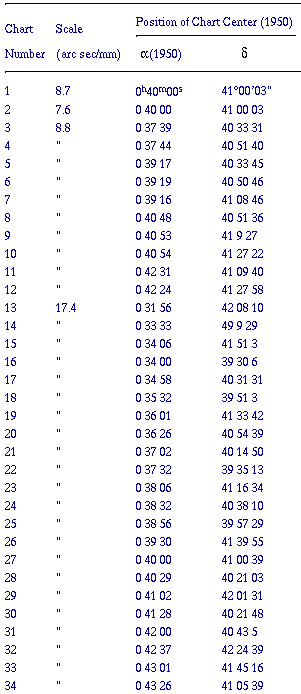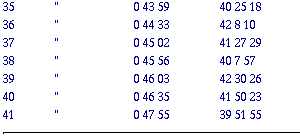


Copyright © 1981 by the University of Washington Press
The main part of this atlas consists of forty-one photographic charts (see table 3), divided into three sets of decreasing enlargement, together with two index charts that show the locations of the main charts. The first two charts (charts 1 and 2) are highly enlarged images of the center of M31, showing the locations of the innermost objects, the nucleus and the nuclear dust regions. The second set (charts 3 through 12) shows moderately highly-enlarged sections of the three 4-meter plates of the central area, divided up so as to show the many objects crowded into these parts of the galaxy. The charts of each set increase in number from west to east.

|

|
The third set (charts 13 through 41) includes the complete collection of 4-meter plates, only slightly enlarged (1.05x) from the original plates. These make up the bulk of the atlas, covering virtually all of M31. Only a very few objects, including remote globular clusters, HI clouds, and satellite dwarf galaxies, lie beyond these charts.
The following objects are identified on the main charts: globular star clusters, open star clusters, stellar associations, and dust clouds. These were chosen because they are the only objects for which relatively complete searches have been made. Table 4 gives information on the symbols used, the numbers of these objects, and the sources for the identifications. These references should be consulted for information on the criteria used for identification, the completeness of the searches, the reliability of the identifications, and other relevant information.

|
Tables A-D in the appendix provide more detailed information on the individual objects identified on the charts. In the case of the globular clusters, we have used the Sargent et al. (1978) listing, which includes all previous discoveries. Table A gives the cluster number, its number in other catalogs, and the charts on which each cluster is identified.
Data on the open star clusters, based on the survey published by Hodge (1979), are presented in table B. In addition to the chart number, a coded description is given, using the following abbreviations:
| L | = | large |
| s | = | small |
| f | = | faint stars only |
| m | = | moderately bright stars present |
| b | = | bright stars conspicuous |
| v | = | very |
Table C lists the stellar associations in M31 that were identified by van den Bergh (1964). His numbers and association boundaries were taken directly from his published charts.
The dust clouds that were mapped and numbered by Hodge (1980) are listed in table D. As is mentioned in that reference, the separation of dust regions into discrete clouds is somewhat arbitrary and done for the convenience that such identifications provide. Many separately-numbered objects are clearly seen to be connected and interlaced on appropriately-exposed plates; any physical interpretation of the plotted dust cloud boundaries must be very tentative. A proper detailed multicolor study would be necessary in order to disentangle the physical structure of any particular dust region.
Not shown on these charts are other kinds of objects identified in M31, objects for which either these charts are not appropriate (e.g., the HII regions and planetary nebulae) or searches are incomplete (e.g., cepheids, X-ray sources, and novae). In many of these cases special charts have been published by the astronomers who discovered them. Table 5 is a guide to the published literature on these objects. In most cases the published charts are easily usable with this atlas for identifying objects and their star fields. It should also be mentioned that a search for globular clusters in M31 has been made by Battistini et al. (1980), whose results were received too late to be included on the charts.
Type of Object | Number Identified | Reference |
| H II regions | 981 | Courtes et al. 1978 |
| H II regions | 686 | Baade and Arp 1964 |
| SN remnants | 7 | Kumar 1976 |
| Planetary nebulae | 311 | Ford and Jacoby 1978 |
| Variable stars | 54 | Baade and Swope 1963 |
| 223 | Gaposchkin 1962 | |
| 50 | Hubble 1929 | |
| Novae | 176 | Rosino 1972 |
| X-ray sources | 69 | van Speybroeck et al. 1979 |
| Supergiants | 11 | Humphreys 1979 |